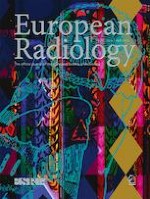Erschienen in:

10.01.2022 | Paediatric
Dynamic contrast-enhanced MR lymphangiography: feasibility of using ferumoxytol in patients with chronic kidney disease
verfasst von:
Ensar Yekeler, Ganesh Krishnamurthy, Christopher L. Smith, Fernando A. Escobar, Erin Pinto, Jordan B. Rapp, Hansel J. Otero, Ammie M. White, Yoav Dori, David M. Biko
Erschienen in:
European Radiology
|
Ausgabe 4/2022
Einloggen, um Zugang zu erhalten
Abstract
Purpose
To assess the feasibility of direct intra-lymphatic administration of diluted ferumoxytol as a T1-positive contrast agent for dynamic contrast-enhanced MR lymphangiography (DCMRL) imaging of the central lymphatics in children with renal disease.
Methods
In vitro scan of dilute ferumoxytol was initially performed using time-resolved and high-resolution 3D gradient echo (GRE) sequences with short TE values (1 to 1.5 ms). A ferumoxytol concentration of 0.25 to 0.40 mg/mL was found to retain high signal in the T1-weighted sequences. DCMRL was then performed in 4 children with renal disease with the same 3D GRE sequences administrating diluted ferumoxytol via intra-mesenteric (IM), intra-hepatic (IH), and intra-nodal (IN) routes (6 to 9 mL to each site; average total dose of 0.75 mg/kg) by slow hand injection (0.5 to 1.0 mL/min). The signal-to-noise ratio (SNR) of the lymphatics was measured for quantitative evaluation.
Results
Ferumoxytol-enhanced DCMRL was technically successful in all patients. Contrast conspicuity within the lymphatics was sufficient without subtraction. The mean SNR was significantly higher than the muscle (50.1 ± 12.2 vs 13.2 ± 2.8; t = 15.9; p < .001). There were no short-term complications attributed to the administration of ferumoxytol in any of the four patients.
Conclusion
Magnetic resonance lymphangiography using ferumoxytol via IN, IH, and IM access is a new method to directly visualize the central lymphatic system and can be applied safely in patients with renal failure based on our preliminary report of four cases. Ferumoxytol-enhanced DCMRL shows diagnostic image quality by using 3D GRE sequences with short TE values and appropriate dilution of ferumoxytol.
Key Points
• MR lymphangiography using ferumoxytol via intra-nodal, intra-hepatic, and intra-mesenteric access is a new method to directly visualize the central lymphatic system from the groin to the venous angle.
• FDCMRL can be applied safely in patients with renal failure based on our preliminary report of four cases.
• FDCMRL shows diagnostic image quality by using 3D GRE sequences with short TE values and appropriate dilution of the ferumoxytol.